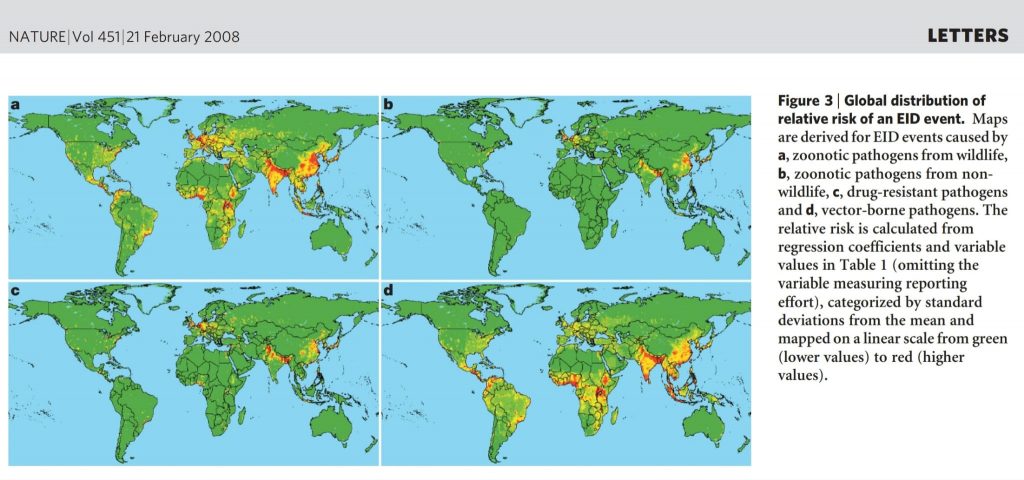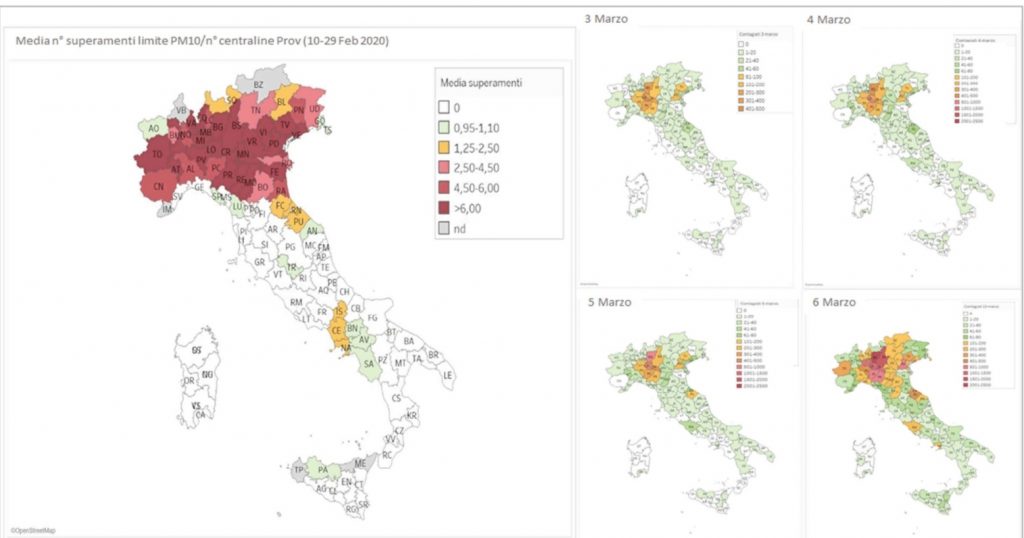Future path of Research Development and correlation with anthropic pollution and ecosystem endangerment

Kate E. Jones published a study on Nature in 2008 identifying 335 Emerging Infectious Diseases (EID) that have been detected from 1940 to 2004, demonstrating non-random global patterns. Origins are significantly correlated with socio-economic, environmental and ecological factors. They also reveal a substantial risk of wildlife zoonotic EIDs in Southern Countries were research funding is low. From this analysis, 60% of emerging diseases that have been detected in humans resulted to be zoonotic. The term “Zoonosis” refers to all diseases transmitted from animals to humans. This raises a question on which is the relationship that ties humans to natural ecosystems where such diseases have originated.
In 2012 David Quammen published Spillover, a book where he highlights the influence of humans on ecosystems and zoonosis diffusion. But what would be the correlation between environmental impact and zoonosis? According to the writer, the spread of viruses is favoured by incorrect behaviour such as the illegal trade in wild species, which can cause numerous cases of disease and even death. This could be one of the possible reasons for the rapid spread of COVID-19. To support this theory, it is suspected that its origin, or intermediate state (after the bat), derives from the consumption of Pangolin meat and scale trading, an endangered mammal and one of the most smuggled animals in the world.
Moving from the cause assessment to an analysis of the current situation: new theories about a causal relation between COVID-19 and pollution are emerging. On one hand, the scientific community agrees on the positive correlation between long-term exposure to pollution and increased mortality rate. However, on the other hand, there is a conflict of thoughts concerning the hypothesis according to which a high rate of particulate matter facilitates the spread of the virus (infectivity rate).
In 2010, a study published by Sedlmaier from the Bavarian Environmental Agency found a link between the infectivity rate of viral avian influenza and high concentrations of PM10 and PM2.5. The claim was confirmed in 2013 when a group of Chinese researchers asserting that the higher the concentrations of pollutants in the air, the greater the number of pathogenic microorganisms in the air. The study carried out in China is currently under analysis for Coronavirus cases.
Looking at Italian research: SIMA (Società Italiana di Medicina Ambientale) published a study in collaboration with the Universities of Bologna and Bari. According to the report, the atmospheric particulate matter would act as a carrier: viruses’ membrane would stick to it and remain in the atmosphere for enough time to increase the infection rate. The rate of inactivation of the virus depends on environmental conditions: the higher the humidity, the more likely it is that the virus will spread. To provide practical evidence, the area of Lombardy (the 1st region in Italy for cases of Coronavirus) has been analyzed. For more than two months (Dec 2019 – Feb 2020) the concentrations of particulate matter and nitrogen dioxide were almost were consistently above the legal limits. Suffice it to say that in mid-February Lombardy had already consumed the 35 days per year of exceeding the limit (50 μg/m3 according to European PM10 standards). A linear relationship between air pollution and cases infected by COVID-19 was therefore recorded.
On the other hand, while from a statistic point of view a covariance of 0.97 reported in the study might seem meaningful, the Italian Aerosol Society (IAS) published a note asserting that there is not enough data to prove a causal relation between Particulate Matter Concentration and COVID-19 infectivity rate. Particularly, the monitoring period is too short to state such a relation.
Also, the system is too complex to be studied under a linear relation analysis (other variables must be included that might range from climate conditions to cultural aspects).
Yet, IAS agreed that the path of this study shall continue with profound investigation. IAS also confirm two relevant aspects:
- Mortality rate (also according to the previously mentioned studies) increases if infected people were exposed to high pollution levels for a prolonged time due to the fact of a proven causal relationship with diabetes, cardiovascular and respiratory diseases.
- Reduction of anthropic emissions in the long term will highly benefit air quality and, therefore, human health (therefore a reduction in health-related costs that might be allocated more efficiently).
Related to this last point it must be said “long term” is a key element. We must always stress out the point that meteorological conditions have no significant relation with climate conditions, that are long term in nature. If the effort to keep pollution down is not undertaken, the reduction of NO2 and Particulate Matter that we faced in this period will be marginalized in a one-year span.
To conclude we must say that this emergency was foreseeable by giving the deserved attention to the scientific community. Particularly, we qualify ecosystems endangerment as the main cause of this pandemic. A Global response under the “One World, One Health” (and also one database) paradigm might be the answer for future risk assessment and prevention.
We, therefore, with pondered critique, want to encourage Governments to follow the scientific community’s recommendations not only in times of crisis but as a form of prevention, also by funding research. Notably, as risk probability is higher in Southern Countries, we also encourage founding in that direction.
Yet, there is no need for prevention at this point, we are already at the edge of Climate Crisis.

Suggested Book:
Quammen David. Spillover: Animal Infection and the Next Human Pandemic, 2012
Related Researches:
Liu, P.; Chen, W.; Chen, J.-P. Viral Metagenomics Revealed Sendai Virus and Coronavirus Infection of Malayan Pangolins (Manis javanica). Viruses 2019, 11, 979.
https://www.mdpi.com/1999-4915/11/11/979/htm
Kate E. Jones, Nikkita G. Patel, Peter Daskaz. Global trends in emerging infectious Diseases. Nature 2008
https://www.nature.com/articles/nature06536
N. Sedlmaier, K. Hoppenheidt, H. Krist, S. Lehmann, H. Lang, et al.. Generation of avian influenza virus (AIV) contaminated fecal fine particulate matter (PM): genome and infectivity detection and calculation of immission. Veterinary Microbiology, Elsevier, 2009
https://hal.archives-ouvertes.fr/hal-00520661/document
Useful Links:
Price Kiley, Animal Isolation, Sustainable Funds, COVID-19 and apes: 3 stories you may have missed. Conservation International, 2020
European Public Health Alliance, Air pollution clears in cities globally – new maps. 2020
Vidal John, Tip of the iceberg: is our destruction of nature responsible for Covid-19? The Guardian, 2020
UniBo/UniBari Study and IAS response (for Italian readers):
Setti Leonardo et al., Relazione circa l’effetto dell’inquinametno da particolato atmosferico e la diffusione di virus nella popolazione. 2020
Italian Aereosol Society, Contributo IAS alla discussion sulla relazione tra inquinamento da particolato atmosferico e diffusione del COVID-19. 2020


